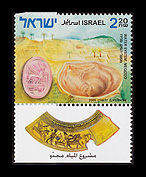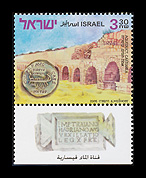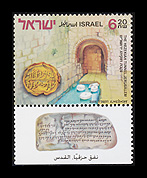|
Where there's no water, there's no life. Thus, in ancient times, man settled near perennial water sources which provided water throughout the year. In the Bronze and Iron Ages however, people built walled cities which isolated them from the water sources. During war they were in great danger if the enemy captured their water source. They dug underground tunnels so that they could reach the water, in secret and safely, from inside the city.
Ancient water systems in fortified settlements, including underground water tunnels, were discovered during excavations of many archeological sites in Eretz Israel. The most well known water systems, mainly from the Iron Age (9th - 7th B .C.E.), were found at Hazor, Megiddo, Yivle'am, Givon, Tel Grisa, Beit Shemesh, Jerusalem, Lachish and Beer Sheva. These water systems are evidence of the engineering capabilities and understanding of hydraulics of the people of that time. They also indicate technical ability in building and quarrying and familiarity with the underground.
As the city population grew, cities were established and the water supply was based on water kept in cisterns near the houses. This lessened the need to defend the water sources. On the other hand, water had to be supplied from sources further away. From the beginning of the Hellenistic period (from the Yd century B.C.E. onwards) aqueducts were built to carry water from springs situated tens of kilometers away from the cities. Construction of the aqueducts required a wide knowledge of building and
precise surveying. During the Roman period the methods were improved. Tunnels were created where there were obstacles on the land which aqueducts had to pass through, and in areas where there were valleys, they built a stable foundation based upon stone arches.
This water system was based on the shaft and slanting tunnel that was carved in the rock within the city and that led to ground water. This was used in the 9th and 8th centuries B.C.E.
The origins of this water system began in the United Kingdom period of the 10th century B.C.E. Later, during the time of the Israelite Monarchy (9th century B.C.E) the system was improved and then used for about two centuries. The users descended the shaft and then horizontally through the tunnel to a spring on the outskirts of the city.
Caesarea was the largest Roman city in Eretz Israel from the time of King Herod in the 1st century B.C.E. and until the Muslim conquest in the 7th century C.E. Herod built the first aqueduct in Caesarea which carried water from the springs on the edge of Mount Carmel and Ramot Menashe. The Latin inscriptions found on the aqueduct indicate that the Romans continued its development and maintenance. Part of the aqueduct, which passes over sand dunes, is supported by a line of stone arches and the rest, which passes through hilly terrain, is in an underground tunnel.
This water system, originating in the late 8th century B.C.E., is located in the City of David in Jerusalem. Hezekiah's tunnel is a masterpiece of ancient water systems and is believed to be the greatest water engineering accomplishment of its type in its time. Residents of Jerusalem quarried the tunnel to lead the water from the Gihon spring to the city. The tunnel was cut in a winding course from both ends successfully meeting at the mountain's interior with only a slight error. Evidence of the success of constructing the tunnel is found in the "Siloam inscription", inscribed on the tunnel's rock wall describing, in ancient Hebrew, the meeting of the quarrymen. King Hezekiah's achievement in ensuring water for the city is mentioned in the Bible (2 Kings 20,20; Isaiah 22 9-11; Chronicles 32 1-4,30. "The other events of Hezekiah's reign and all his exploits, and how he made the pool and the conduit and brought the water into the city are recorded in the Annals of the Kings of Judah" 2 Kings 20,20.
Professor Ronny Reich
University of Haifa




